Vintage Clothing History Guide - Men's Hats
The wearing of hats can be traced as far back as primitive man. Historical evidence has shown that some form of head covering was used for protection against the elements. Throughout early Egyptian, Roman and Greek times, the hat was worn as a mark of rank. It is believed that felt, the most common material used in hat making, was originally discovered by the nomadic tribes of Asia who were known to have used felted sheep's wool for making tents and clothing.
Throughout the centuries both men and women have sported various forms of headdress but it was only in the late 14th and 15th centuries that hats started to be worn. During that period hats for men were considered an important fashion item, unlike women's hats which only became considered a fashion item in the 18th Century.
As hats gradually grew in popularity during the 15th Century, they were made from an increasingly diverse range of materials such as silk, velvet, taffeta, leather, felt and beaver. During this period, hat wearing differed between men and women. With women it tended to be restricted to the upper and middle classes plus countrywomen, whereas with men it represented an essential accessory. During this period too, there was little difference in the style of hats worn by men and women. Many of the masculine styles tended to be adopted by fashionable women and especially those belonging to the middle classes.
Men's hats over the years have tended to make a symbolic statement. The most notable being the formal, stiff top hat representing from the mid 19th Century authority of the bourgeoisie and aristocracy and those who were involved in the professions and trades. Later the soft trilby felt hats symbolised democracy and revolution and were generally associated with intellectuals, artists and country life. Here is a summary of some of most popular styles of mens vintage hats throughout history:
The Bowler Hat
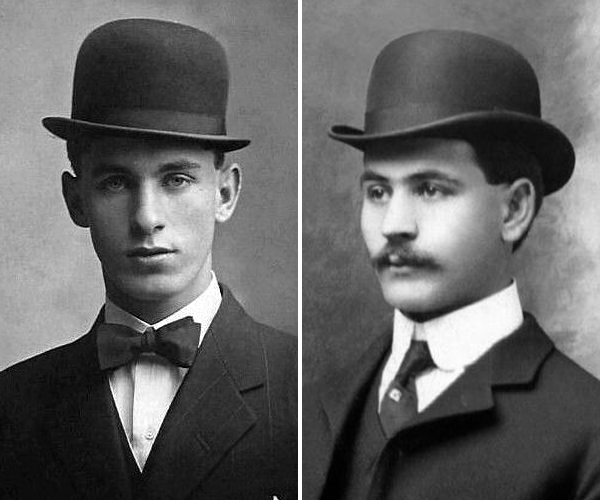
The Coke, more commonly known as the Bowler, was created at James Lock in 1850 for William Coke, a progressive farmer from Norfolk. It was a domed hat, hardened by the application of shellac, devised to protect the heads of gamekeepers from overhanging branches of trees, and closely fitting the head so that it would not easily blow or fall off. The prototype was made by Thomas and William Bowler, hat makers in Southwark. It was brought to St. James’s Street to be tested by William Coke himself. This he did by jumping on it and as it withstood his weight he bought it.
At the shop this masterpiece was naturally identified as a Coke, but later when it went into production at the rate of sixty thousand a year, it became generally known as a Bowler, after its maker. In America it became a Derby from its association with the famous horse race.
The Straw Boater
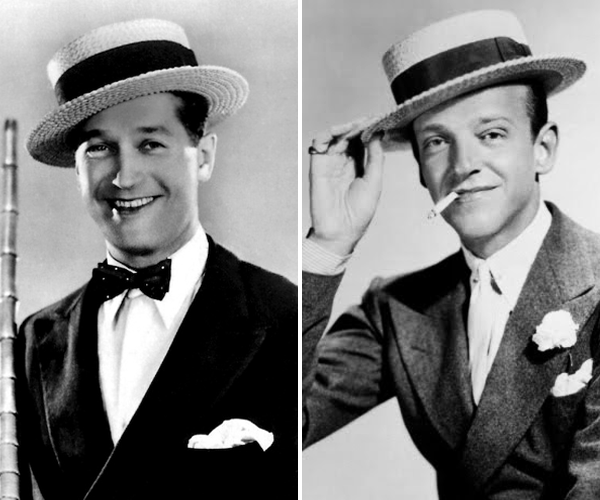
The origins of today's boater are the sailor's hat issued to midshipmen in the Royal Navy near the end of the nineteenth century. They were not as stiff as the modern boater but provided protection from tropical sun. These hats were adopted by children in Victorian England and became part of their school uniforms wearing their school or house colours as hatbands.
The boater became a popular form of summer headwear for gentlemen as a lighter and cooler alternative to the bowler. For a while they also became popular with costermongers in the East End of London but today they are a rare sight, as it has been eclipsed by the Panama, and are mainly seen as part of the summer social scene at Henley Royal Regatta.
The Trilby
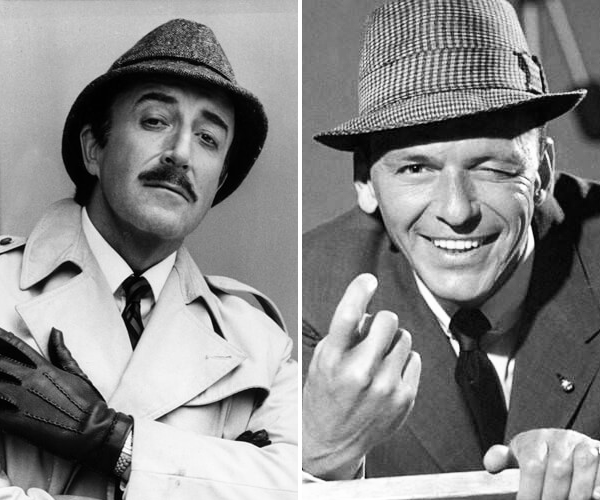
The Trilby is named after the female heroine of a novel of the same name written by George du Maurier. The novel was serialised in Harper’s New Monthly Magazine and was also made into a stage play. Trilby O'Ferral, the beautiful artist's model who fell under the spell of Svengali, wore the soft indented felt hat in an 1895 dramatisation.
After the turn of the century the Trilby became popular as men rejected the more formal stiff hats that were the vogue of the previous century. The Trilby was very much an American fashion but quickly spread to the rest of the world helped by the medium of film. They tend to have a fixed brim which is shorter than that found on a fedora hat.
The Fedora
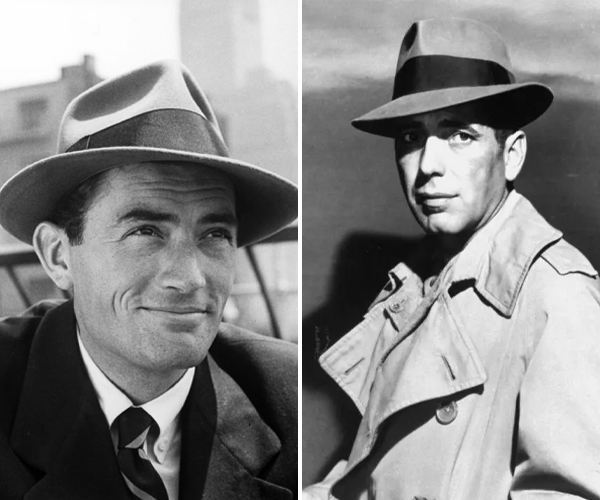
The name Fedora comes from the heroine of French playwright Victorian Sardou's drama presented in Paris in 1882. The hat soon became popular with men in the same way as the trilby. Fedoras are a more formal hat style than the trilby & would be a perfect choice to complete a 1940s mens outfit.
A high quality material and construction for the fedora is a must. The crown is usually four or four and a half inches, with a pronounced 'pinch' in the front of the crown. Although a short brim has been popular from time to time, a classic fedora has a brim between two to two and a half inches. A wide brim of three or more inches has also become recently popular. The brim is always a 'snap' brim, meaning that the front or the front and back of the fedora can be snapped up or down, for styling or to protect the wearer from the elements.
The Panama
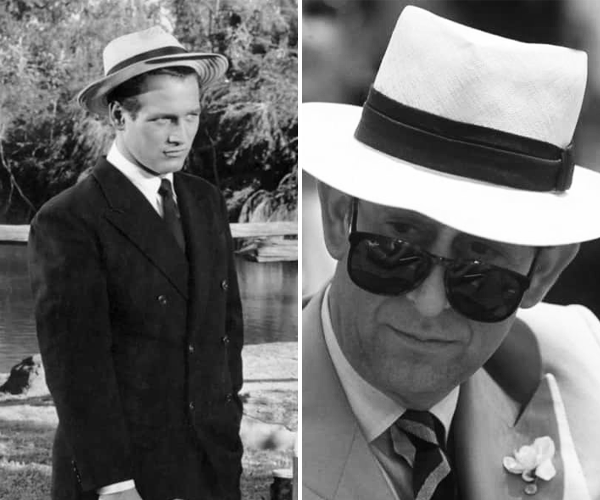
Panama hats are made exclusively in Ecuador and are hand-woven from the Tequila Palm. The origins of the hat go back to the 16th century when the Incas were the first to use the Tequila palm to make hats.
The term Panama comes from the number of workers building the Panama Canal who used the hat for protection against the sun.
In 1855, a Frenchman living in Ecuador took some samples to the World Exhibition in Paris and the finest quality Panama was presented to Emperor Napoleon III.
Every Panama hat is unique as the making of the hats is a cottage industry and some of the finest pajamas are made in Montecristi. The finest woven hats can take up to 6 months to weave and can command prices of up to £1000. The best hats have to be woven in the right conditions and especially humidity. The weavers split the fibre razor thin and plait ring after ring of palm fibre constantly dipping their finger tips into water.
The finest Panamas have a very silky texture and when held up to the light you can see a spiral of rings together with the weaver's signature. These rings are called 'vueltas' and the more there are determines the quality of the hat. The cheaper quality hats may only have around ten 'vueltas' whereas a Montecristi Superfino may have up to forty.
Panamas are exported from Ecuador in the form of hoods. These are then blocked by specialist hat factories into the two principal shapes which is the Trilby and the Folding Panama. The origin of the black band on the Panama dates back to 1901 when Queen Victoria died.
The Top Hat

The top hat was originally a French invention and quickly became the status symbol for the nineteenth century gentleman and replaced the cocked tricorns and bicorns that had been fashionable in the previous century.
The first top hats were made from beaver but a new material appeared called 'hatter's plush' which is the trade's term for what the public think of as silk. It was very fine silk shag, applied to the felt to give it a nap.
The first man who was credited with wearing this new creation in London, the hatter John Hetherington, nearly caused a riot and was arrested for wearing a hat that was 'calculated to frighten timid people'.
After this poor start the top hat soon became the conventional headwear for gentleman in Britain, Europe and the United States. It was seen as a symbol of wealth and social standing and able to enhance the wearer by making them seem taller, more refined and handsome.
Back in France a Monsieur Gibus had invented a collapsible top hat known as the chapeau claque. This made storage much easier and could be easily placed under the seat of an opera house which gave the hat the name 'opera hat' or the wearer could hold it under his arm giving the hat a third name 'chapeau bras' (arm hat).
Today top hats are still worn all over the world at weddings and if you are invited to the Royal Enclosure at the Royal Ascot race meeting gentleman must be wearing either a grey or black top hat.
The Homburg
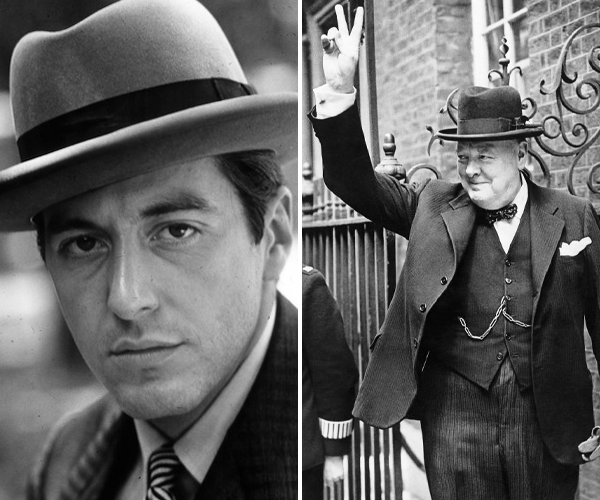
The Homburg is a felt hat with a centre dent creased crown and a stiff brim with an upturned edge. The hat is traditionally trimmed with a grosgrain hat band. The hat was made popular by Edward VII after he brought one back from Bad Homburg, a district of Hesse in Germany. This is also where the hat's name originated from. In the German Empire it was originally worn as hunting headgear. After bringing this hat back with him, many copied the style leading to a massive surge in popularity of this hat.
During the 1930s, Anthony Eden (who would later become Prime Minister) became known for wearing a homburg style hat. This gave rise to the nickname the 'Eden' hat or sometimes simply the 'Anthony Eden'. The homburg had another spike in popularity when in 1953, Dwight D. Eisenhower broke with tradition by wearing a black homburg instead of a top hat at his inauguration as President. However this hat style is perhaps most closely associated with Winston Churchill. The other most notable wearer of this hat was Al Pacino in The Godfather movie which is where this hat gets its other nickname of the 'Godfather' hat.
